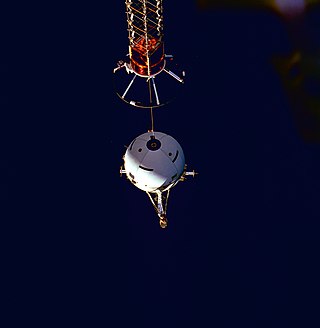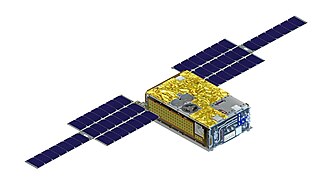
STS-75 was a 1996 NASA Space Shuttle mission, the 19th mission of the Columbia orbiter.

A CubeSat is a class of miniaturized satellite with a form factor of 10 cm (3.9 in) cubes. CubeSats have a mass of no more than 2 kg (4.4 lb) per unit, and often use commercial off-the-shelf (COTS) components for their electronics and structure. CubeSats are put into orbit by deployers on the International Space Station, or launched as secondary payloads on a launch vehicle. As of December 2023, more than 2,300 CubeSats have been launched.

The National Institute for Aerospace Technology "Esteban Terradas" is an autonomous agency of the Spanish public administration dependent on the Secretariat of State for Defence (SEDEF). It is responsible for the aerospace, aeronautics, hydrodynamics, and defense and security technologies research.
The Space Test Program (STP) is the primary provider of spaceflight for the United States Department of Defense (DoD) space science and technology community. STP is managed by a group within the Advanced Systems and Development Directorate, a directorate of the Space and Missile Systems Center of the United States Space Force. STP provides spaceflight via the International Space Station (ISS), piggybacks, secondary payloads and dedicated launch services.

The National Aeronautics and Space Administration is an independent agency of the U.S. federal government responsible for the civil space program, aeronautics research, and space research. Established in 1958, it succeeded the National Advisory Committee for Aeronautics (NACA) to give the U.S. space development effort a distinctly civilian orientation, emphasizing peaceful applications in space science. It has since led most American space exploration, including Project Mercury, Project Gemini, the 1968–1972 Apollo Moon landing missions, the Skylab space station, and the Space Shuttle. It currently supports the International Space Station and oversees the development of the Orion spacecraft and the Space Launch System for the crewed lunar Artemis program, the Commercial Crew spacecraft, and the planned Lunar Gateway space station.

Soil Moisture Active Passive (SMAP) is a NASA environmental monitoring satellite that measures soil moisture across the planet. It is designed to collect a global 'snapshot' of soil moisture every 2 to 3 days. With this frequency, changes from specific storms can be measured while also assessing impacts across seasons of the year. SMAP was launched on 31 January 2015. It was one of the first Earth observation satellites developed by NASA in response to the National Research Council's Decadal Survey.

A number of space tethers have been deployed in space missions. Tether satellites can be used for various purposes including research into tether propulsion, tidal stabilisation and orbital plasma dynamics.
Technology Education Satellite (TechEdSat) is a successful nano-sat flight series conducted from the NASA Ames Research Center in collaboration with numerous universities. While one of the principal aims has been to introduce young professionals and university students to the practical realm of developing space flight hardware, considerable innovations have been introduced. In addition, this evolving flight platform has tested concepts for Low Earth Orbit (LEO) sample return, as well as planetary nano-sat class mission concepts.

AESP-14 is a Brazilian 1U Cubesat developed by multiple Brazilian institutions. It was launched on 10 January 2015 aboard the SpaceX CRS-5 mission on a Falcon 9 v1.1 rocket. It was the first Brazilian Cubesat ever launched into space.

Lunar IceCube is a NASA nanosatellite orbiter mission that was intended to prospect, locate, and estimate amount and composition of water ice deposits on the Moon for future exploitation. It was launched as a secondary payload mission on Artemis 1, the first flight of the Space Launch System (SLS), on 16 November 2022. As of February 2023 it's unknown whether NASA team has contact with satellite or not.

Lunar Polar Hydrogen Mapper, or LunaH-Map, was one of the 10 CubeSats launched with Artemis 1 on 16 November 2022. Along with Lunar IceCube and LunIR, LunaH-Map will help investigate the possible presence of water-ice on the Moon. Arizona State University began development of LunaH-Map after being awarded a contract by NASA in early 2015. The development team consists of about 20 professionals and students led by Craig Hardgrove, the principal investigator. The mission is a part of NASA's SIMPLEx program.

ESTCube-2 was a three-unit CubeSat built by the Estonian Student Satellite Foundation. ESTCube-2 launched from Kourou, French Guiana, with the European Space Agency's Vega launch vehicle on 9 October 2023 at 4:36 a.m. EEST. The satellite failed to deploy and was destroyed on reentry.

EQUULEUS is a nanosatellite of the 6U CubeSat format that will measure the distribution of plasma that surrounds the Earth (plasmasphere) to help scientists understand the radiation environment in that region. It will also demonstrate low-thrust trajectory control techniques, such as multiple lunar flybys, within the Earth-Moon region using water steam as propellant. The spacecraft was designed and developed jointly by the Japan Aerospace Exploration Agency (JAXA) and the University of Tokyo.

Bi-sat Observations of the Lunar Atmosphere above Swirls (BOLAS) is a spacecraft mission concept that would orbit the Moon at very low altitude in order to study the lunar surface. The concept, currently under study by NASA, involves two small identical CubeSat satellites connected vertically above the lunar surface by a 25 km long tether. The mission goal would be to understand the hydrogen cycle on the Moon, dust weathering, and the formation of lunar swirls.
The Innovative Satellite Technology Demonstration Program is a series of spacecraft missions for testing technology and ideas put forward by universities and private companies. The program demonstrates various experimental devices and technology in space by providing flight opportunities. It is managed by the JAXA Research and Development Directorate. According to JAXA, the goal of this program is to test high risk, innovative technology that will lead to the space industry gaining competitiveness in the international field.

Simulation-to-Flight 1 (STF-1) is a microsatellite built by the Katherine Johnson Independent Verification and Validation Facility (IV&V) in Fairmont, West Virginia with the collaboration of the West Virginia Space Grants Consortium and West Virginia University.

HuskySat-1 is an artificial satellite designed at the University of Washington. It was launched by Cygnus NG-12 from Mid-Atlantic Regional Spaceport Launch Pad 0 on Wallops Island, Virginia to low earth orbit on November 2, 2019. It is a CubeSat, and will demonstrate onboard plasma propulsion and high gain telemetry for low Earth orbit that would be a precursor for an attempt at a larger CubeSat designed for orbital insertion at the Moon.

SpaceX CRS-26, also known as SpX-26, was a Commercial Resupply Service mission to the International Space Station (ISS) launched on 26 November 2022. The mission was contracted by NASA and flown by SpaceX using a Cargo Dragon. This was the sixth flight for SpaceX under NASA's CRS Phase 2 contract awarded in January 2016.

SpaceX CRS-27, also known as SpX-27, was a Commercial Resupply Service mission to the International Space Station (ISS) launched on 15 March 2023. The mission was contracted by NASA and was flown by SpaceX using Cargo Dragon C209. This was the seventh flight for SpaceX under NASA's CRS Phase 2.















